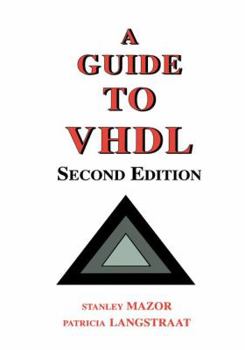A Guide to VHDL
Select Format
Select Condition 
Book Overview
A Guide to VHDL, Second Edition is intended for the working engineer who needs to develop, document, simulate, and synthesize a design using the VHDL language. It is for system and chip designers who are working with VHDL CAD tools, and who have some experience programming in Fortran, Pascal, or C and have used a logic simulator. A Guide to VHDL, Second Edition includes a number of paper exercises and computer lab experiments. If a compiler/simulator is available to the reader, then the lab exercises included in the chapters can be run to reinforce the learning experience. For practical purposes, this book keeps simulator-specific text to a minimum, but does use the Synopsys VHDL Simulator command language in a few cases. A Guide to VHDL, Second Edition is designed as a primer and its contents are appropriate for an introductory course in VHDL. The VHDL language was updated in 1992 with some minor improvements. In most cases, the language is upward compatible. Although this book is based primarily on the VHDL 1987 standard, this new second edition indicates the significant changes in the 1992 language to assist the designer in writing upwardly compatible code.
Format:Hardcover
Language:English
ISBN:0792393872
ISBN13:9780792393870
Release Date:September 1993
Publisher:Springer
Length:311 Pages
Weight:2.10 lbs.
Dimensions:0.8" x 7.0" x 10.0"
Customer Reviews
3 ratings
A guide to get started in VHDL
Published by Thriftbooks.com User , 17 years ago
As the author, I wrote this book as an introduction for someone who wanted to learn to use this design language. It is not particulary suitable as a reference guide, but instead is organized to help you grasp the fundamental relationships and organization of the VHDL language. Even for experienced programmers some of the concepts are a bit hard at first. We try also to include the motivations and uses for various features. There are a number of simple examples included. I hope you enjoy and use this book. stan mazor
A good book on fundamentals
Published by Thriftbooks.com User , 18 years ago
I just borrowed the book from the library and I am reading through it to understand VHDL. It is good for my background: I know more than ten programming languages, know digital logic design, and is familiar with Verilog. I had read a few other VHDL books, but was kind of confused by their writing styles. I like this book because it tells the rationals behind the VHDL design. It is focused on the design of the language itself. The other books I read tried to cover many things like microprocessor design or DSP design, but didn't clarify why VHDL uses concepts like entity, architecture, process, etc. For a professional, it is fast to learn VHDL from this book. But this book is possibly not a good book for a student because of its focus. It lacks detail (not a good reference book) and doesn't have many examples.
Great book to start on VHDL......and beyond
Published by Thriftbooks.com User , 23 years ago
If you want to build a solid foundation in VHDL, this is the book to buy. I absolutely loved it.






